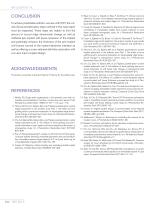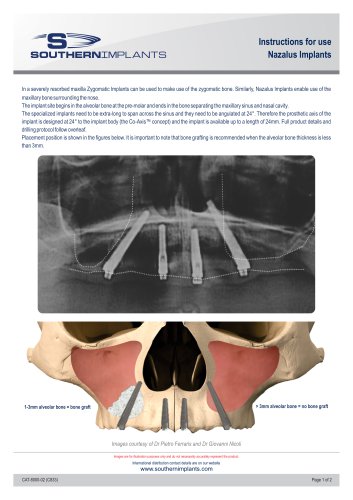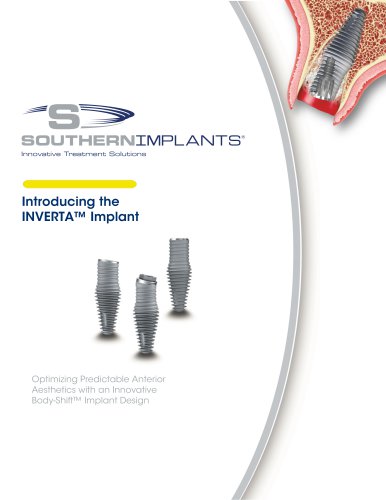
Catalog excerpts

Special Reprint from QUINTESSENCE OF DENTAL TECHNOLOGY Sillas Duarte, Jr, dds, ms, phd ©2019 by Quintessence Publishing Co Inc
Open the catalog to page 1
Private Practice, New York, New York, USA. Assistant Professor, Division of Periodontics, University of Maryland School of Dentistry, Baltimore, Maryland, USA. 3 Adjunct Clinical Professor, Ashman Department of Periodontology and Implant Dentistry/Department of Prosthodontics, New York University College of Dentistry, New York, New York, USA. 1 Correspondence to: Dr Hanae Saito, Division of Periodontics, University of Maryland School of Dentistry, 650 W Baltimore Street, Office 4211, Baltimore, MD 21201, USA. Email: hsaito@umaryland.edu
Open the catalog to page 2
The Use of Dual- or Co-Axis Macro-Designed Implants to Enhance Screw-Retained Restorations in the Esthetic Zone Adam J. Mieleszko, CDT1 Hanae Saito, DDS, MS, CCRC2 Stephen J. Chu, DMD, MSD, CDT3 mplant placement into postextraction sockets with a provisional restoration in nonfunctional occlusion (immediate tooth replacement therapy) in the maxillary anterior region has increased in use and clinical relevance since its introduction in the late 1990s.1 Treatment procedures are condensed into fewer patient appointments, reducing overall treatment time and increasing patient comfort.2–4...
Open the catalog to page 3
Figs 1a and 1b Pretreatment extraoral smile and labial views of the maxillary right central incisor. The patient exhibits a high smile line. A 20-year-old porcelain-fused-to-metal crown and gingiva show discoloration due to a dark root after root canal treatment. Fig 2 Pretreatment periapical radiograph and CBCT shows a thin labial plate, narrow socket dimension, and bone apical and palatal to the tooth root. In addition, the use of macro changes in implant design, specifically angle correction or Co-Axis implants (Southern Implants), may minimize the need for custom abutments and...
Open the catalog to page 4
The Use of Dual- or Co-Axis Macro-Designed Implants to Enhance Screw-Retained Restorations in the Esthetic Zone Fig 3 Extraction was performed in an atraumatic manner without flap elevation. An intact buccal plate was confirmed. Figs 4a and 4b Buccal soft tissue thickness 2.0 mm below the free gingival margin was measured with an Iwanson rounded-end springless caliper. Thin buccal soft tissue of 0.5 mm was noted. Fig 5 Osteotomy was done according to the manufacturer’s recommendation, and the angulation of the implant followed the incisal edges of the adjacent teeth. Fig 6 Implant...
Open the catalog to page 5
Figs 8a and 8b Prefabricated polymethyl methacrylate (PMMA) shell device was placed into the socket over the implant. Fig 9 PMMA temporary abutment placed onto the implant. The platform angle correction enabled optimal angulation of the prosthetic abutment relative to the extraction socket. Figs 10a and 10b Palatal aspect of prefabricated shell device was modified to facilitate the temporary screw-retained cylinder. Fig 11 Space between the temporary abutment and shell device was filled with autopolymerizing resin. Fig 12 The preoperative impression was used to form an “egg shell” in a...
Open the catalog to page 6
The Use of Dual- or Co-Axis Macro-Designed Implants to Enhance Screw-Retained Restorations in the Esthetic Zone Figs 14a and 14b Healing abutment was placed into the implant to protect the screw access hole, and cancellous particulate allograft was placed up to the free gingival margin. Fig 15 Provisional restoration was placed and excess bone graft was removed. Figs 16a and 16b Buccal and occlusal views after the immediate tooth replacement therapy. Fig 17 CBCT taken right after the immediate tooth replacement therapy showed platform angle correction and avoidance of apical perforation...
Open the catalog to page 7
Figs 20a and 20b Shade selection using the shade tabs with regular and polarized photography. Figs 21a to 21c Laboratory fabrication of the prosthetic screw-retained abutment/crown. (a) Soft tissue model, (b) which showed increase of buccal peri-implant soft tissue of 2.0 mm (net of 2.5 mm) from the initial thickness of 0.5 mm, and (c) metal prosthetic framework. Fig 22 Incisal third of the restoration contains some grayish-violet to create the illusion of depth, and the gingival third has a more chromatic hue profile. Fig 23 Segmental lateral buildup: Incisal third with grayish-violet...
Open the catalog to page 8
The Use of Dual- or Co-Axis Macro-Designed Implants to Enhance Screw-Retained Restorations in the Esthetic Zone Fig 24 Shade was verified using a polarized filter and the same shade tabs used for shade selection. Fig 25 Gold powder applied to verify the texture and luster of the restoration independent of the shade. Fig 26 Try-in of the final restoration. Modifications to the distal contour, chroma, and surface texture were required. Figs 27a to 27d Fine tuning of the crown, fabricated of porcelain fused to gold-ceramic alloy, with additional texture, incisal transparency, and contour....
Open the catalog to page 9
Figs 28a to 28c Screw-retained final restoration placed. (a) Labial view, (b) distal papilla, and (c) smile view. The patient was pleased with the result. Fig 29 Periapical radiograph of the final restoration placed 9 months after the placement of a dental implant.
Open the catalog to page 10
The Use of Dual- or Co-Axis Macro-Designed Implants to Enhance Screw-Retained Restorations in the Esthetic Zone Figs 30a to 30e (a) Occlusal, (b) smile, (c) distal papilla, (d) profile, and (e) polarized image views taken 6 months after the delivery of final restoration. Note maintained buccolingual ridge width and midfacial soft tissue height compared to contralateral tooth (maxillary left central incisor).
Open the catalog to page 11
CONCLUSION To achieve predictable esthetic success with ITRT, the critical clinical and laboratory steps outlined in this case report must be respected. These steps are helpful to limit the amount of buccal ridge dimensional change as well as midfacial peri-implant soft tissue recession of the implant and potentially enhance the thickness of the peri-implant soft tissues coronal to the implant-abutment interface as well as offering a screw-retained definitive restoration with a co-axis macro implant design. ACKNOWLEDGMENTS The authors would like to thank Dr Dennis P. Tarnow for the skillful...
Open the catalog to page 12All SOUTHERN IMPLANTS (Pty) Ltd. catalogs and technical brochures
-
IT CONNECTION
28 Pages
-
CIA Scanning Abutment Range
1 Pages
-
TIB Abutment
2 Pages
-
OsteoBiol®
60 Pages
-
MSc EXTERNAL HEX
40 Pages
-
Southern Implants Hex Family
6 Pages
-
PROSTHETIC REHABILITATION
4 Pages
-
OSSEOINTEGRATED FIXTURES
16 Pages
-
MAX IMPLANT
4 Pages
-
Product Catalogue
100 Pages
-
Osteobiol
1 Pages
-
TRI-NEX
52 Pages
-
Deep Conical Surgical
40 Pages
-
Co-Axis®
1 Pages
-
INVERTA
36 Pages



























